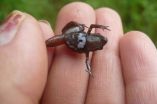Why the human heart cannot regenerate
FAU researchers discover endogenous process that controls reproduction of cardiac muscle cells and may lead to new treatments for heart attacks and cancer
2015-08-06
(Press-News.org) The results of their research have recently been published in the high-profile journal eLife*.
The ability of most cardiac muscle cells to reproduce disappears in humans and all other mammals shortly after birth. What remains unclear, however, is how this happens and whether it is possible to restore this ability and therefore to regenerate the heart.
FAU researchers Dr. David Zebrowski and Prof. Dr. Felix B. Engel from the Department of Nephropathology at Universitätsklinikum Erlangen's Institute of Pathology and their colleagues have now found a possible explanation for this phenomenon. 'In our study we discovered that the centrosome in cardiac muscle cells undergoes a process of disassembly which is completed shortly after birth,' Prof. Engel explains. 'This disassembly process proceeds by some proteins leaving the centrosome and relocating to the membrane of the cell nucleus in which the DNA is stored. This process causes the centrosome to break down into the two centrioles of which it is composed, and this causes the cell to lose its ability to reproduce.'
The centrosome is an organelle found in almost every cell. In recent years, experiments have shown that if the centrosome is not intact, the cell can no longer reproduce. This raised the key question to what extent centrosome integrity could be manipulated - such as in cancer where cells reproduce at an uncontrolled rate.
The FAU researchers have now investigated whether the state of centrosome integrity is regulated naturally in the animal kingdom in order to control the reproduction of certain cells.
A dramatic difference
'We were incredibly surprised to discover that the centrosome in the cardiac muscle cells of zebrafish and amphibians remains intact into adulthood,' says Dr. David Zebrowski, who has been studying centrosomes for five years. 'For the first time, we have discovered a significant difference between the cardiac muscle cells of mammals and those of zebrafish and amphibians that presents a possible explanation as to why the human heart cannot regenerate.'
The discovery that there is a natural process that regulates centrosome integrity in the cardiac muscle cells of mammals opens up a range of possibilities for future research. Firstly, this observation provides a new starting point for attempts to stimulate the reproduction of cardiac muscle cells in humans to regenerate the heart. At the same time, centrosome integrity can be examined in order to find adult cardiac muscle cells that may have retained their ability to reproduce, which may enable new forms of medical treatment. Finally, a detailed understanding of the mechanism could also help researchers to develop methods of inhibiting the uncontrolled growth of cancer cells.
The study on heart regeneration was carried out as part of the project CYDER (Cell Cycle in Disease and Regeneration) that was set up by Prof. Dr. Felix B. Engel, an expert in the field of heart regeneration. CYDER has been funded by FAU's Emerging Fields Initiative since 2014. EFI aims to promote outstanding, preferably interdisciplinary research projects at an early stage and in a flexible and non-bureaucratic way. A strict selection process guarantees the high quality of the projects, approaches and the researchers funded within the scheme.
INFORMATION:
*The paper is available at http://dx.doi.org/10.7554/eLife.05563.
ELSE PRESS RELEASES FROM THIS DATE:
2015-08-06
Carrying itself around with a dark brown mask on its face and a broad shapeless white mark on its chest and belly, a frog had been jumping across the Peruvian cloud forests of the Andes unrecognised by the scientific world. Now, this visibly distinguishable species has been picked up by Dr. Catenazzi of Southern Illinois University and his team from its likely only locality, a cloud forest near Cusco in Peru, at 2350 m elevation by Drs. Catenazzi, Uscapi and May. Their research is published in the open-access journal ZooKeys.
The new fleshbelly frog species, called N. ...
2015-08-06
Researchers from the International Research Institute of Disaster Science (IRIDeS) at Tohoku University in Sendai, Japan, have been looking into how tsunami-type waves can originate from massive storm systems, independent of earthquakes or landslides.
According to Volker Roeber and Jeremy D. Bricker, massive storm systems can be the cause of devastating tsunami-type waves. It happened during Typhoon Haiyan, which struck the Philippines in November 2013. Typhoon Haiyan was one of the strongest typhoons ever recorded, causing more than 6,000 casualties.
A development ...
2015-08-06
People who recognise they are overweight or obese are more likely to put on weight than those who are unaware that they may be heavier than doctors would advise, according to research by the University of Liverpool.
In a study, published in the International Journal of Obesity, researchers looked at the lives of 14,000 adults in the US and the UK through data captured in three studies: the US National Longitudinal Study of Adolescent to Adult Health, the UK National Child Development Study and Midlife in the United States.
They analysed data from time periods after ...
2015-08-06
Lack of microinvaginations in the cell membrane, caveolae, can cause serious diseases such as lipodystrophy and muscular dystrophy. Researchers at Lund University in Sweden have now discovered a "main switch" that regulates the formation of these invaginations.
Many cells in the body are equipped with small microinvaginations in the cell membrane called caveolae. They are important for the cell's ability to take up molecules and particles from the cell surface into the cell. If this doesn't work, the function of the cell is disturbed, resulting in diseases. Having too ...
2015-08-06
New camera technology that reveals the world through the eyes of animals has been developed by University of Exeter researchers. The details are published today in the journal Methods in Ecology and Evolution.
The software, which converts digital photos to animal vision, can be used to analyse colours and patterns and is particularly useful for the study of animal and plant signalling, camouflage and animal predation, but could also prove useful for anyone wanting to measure colours accurately and objectively.
The software has already been used by the Sensory Ecology ...
2015-08-06
Dasabuvir (trade name Exviera) and the fixed-dose drug combination ombitasvir/paritaprevir/ritonavir (trade name Viekirax) have been available since January 2015 for the treatment of adults with chronic hepatitis C infection. The German Institute for Quality and Efficiency in Health Care (IQWiG) had examined their added benefit in a dossier assessment completed in April 2015.
In an addendum, the Institute now assessed study data subsequently submitted by the drug manufacturer in the commenting procedure. According to the findings, the results of an indirect comparison ...
2015-08-06
Why some planets, like Saturn or Jupiter, have their rings, while others like, the Earth or Mars do not? It turned out that "the size does not matter" -- not only giants as Saturn possess the rings, but even tiny asteroids do: According to the recent discovery of the Spitzer Space Telescope, the remote asteroid Chariklo, which is only 260 km in diameter, also has rings.
A natural answer may be the following: Occasionally, in a far past, some planets had much more material in their vicinity then the other ones. The material was in a form of dust. Dust particles merged ...
2015-08-06
UC Davis study should help guide patients and their oncologists
(SACRAMENTO, Calif.) -- Combing data collected on thousands of California ovarian cancer patients, UC Davis researchers have determined that almost one-third survived at least 10 years after diagnosis.
The unprecedented findings upend the notion that women diagnosed with cancer of the ovary always face a poor chance of survival. In fact, while the study confirmed earlier findings on characteristics associated with ovarian cancer survival -- younger age, earlier stage and lower grade tumors at diagnosis ...
2015-08-06
The dull black plastic of the device on Joshua Pearce's desk belies its usefulness. Pearce picks up the box, which has a switch on the side and a small opening on top. A handful of vials sit in a bag nearby, and each would fit snugly in the opening. The set-up seems generic, even bland, except that it could radically change how we deal with water quality issues.
Pearce, who has a joint appointment as an associate professor of materials science and engineering as well as electrical and computer engineering, runs an open sustainability technology lab at Michigan Technological ...
2015-08-06
COLLEGE STATION - Woody plant encroachment is one of the biggest challenges facing rangelands worldwide, but it consistently has been under-measured and poorly understood, said a Texas A&M AgriLife Research scientist in College Station.
Dr. Matthew Berg, an AgriLife Research postdoctoral research associate in the Texas A&M department of ecosystem and science management, is trying to change both the understanding and measurement with his latest study, which was captured in the July issue of the Rangeland Ecology and Management publication, http://bit.ly/1JK8JhU.
Berg ...
LAST 30 PRESS RELEASES:
[Press-News.org] Why the human heart cannot regenerate
FAU researchers discover endogenous process that controls reproduction of cardiac muscle cells and may lead to new treatments for heart attacks and cancer




